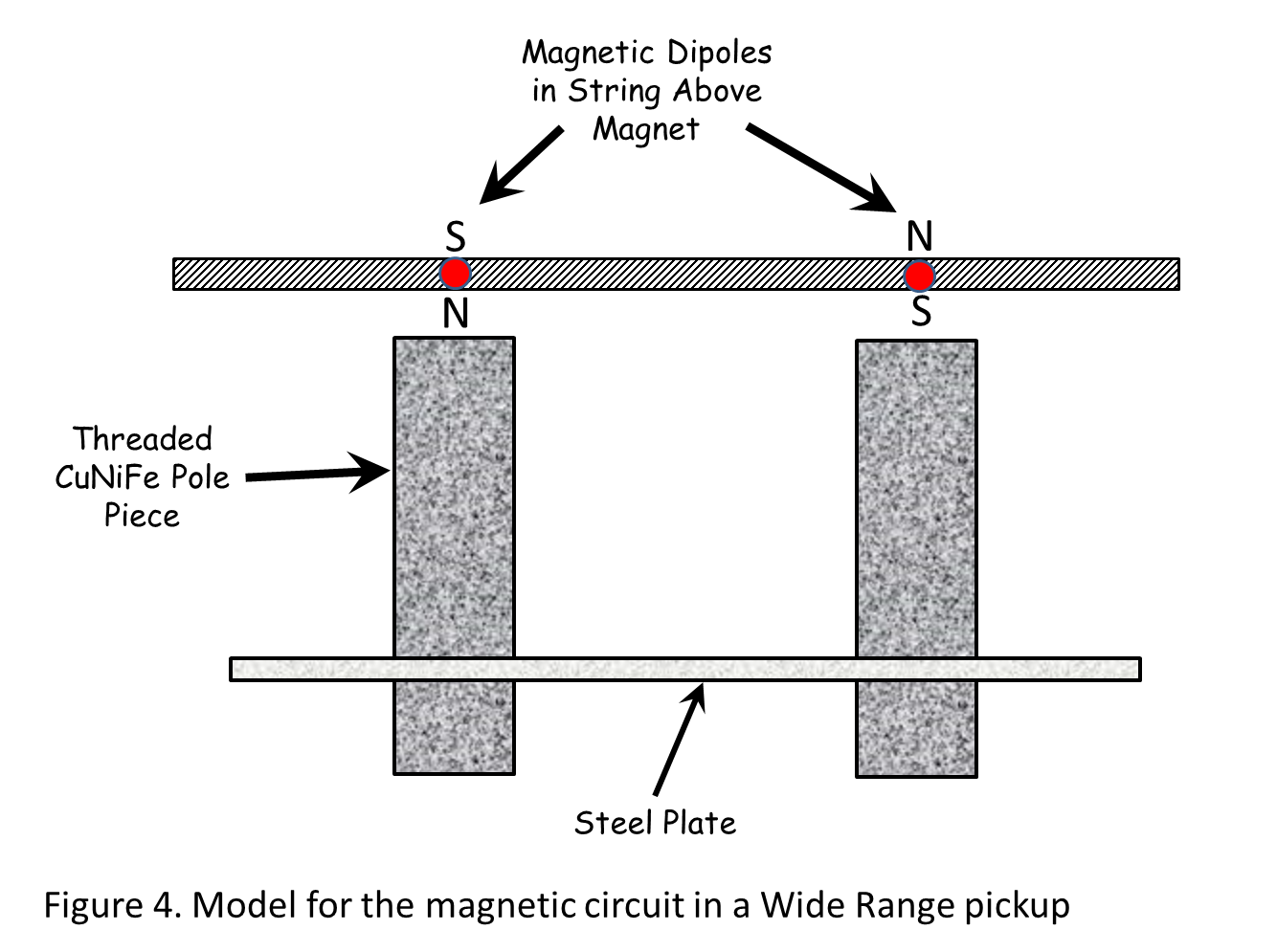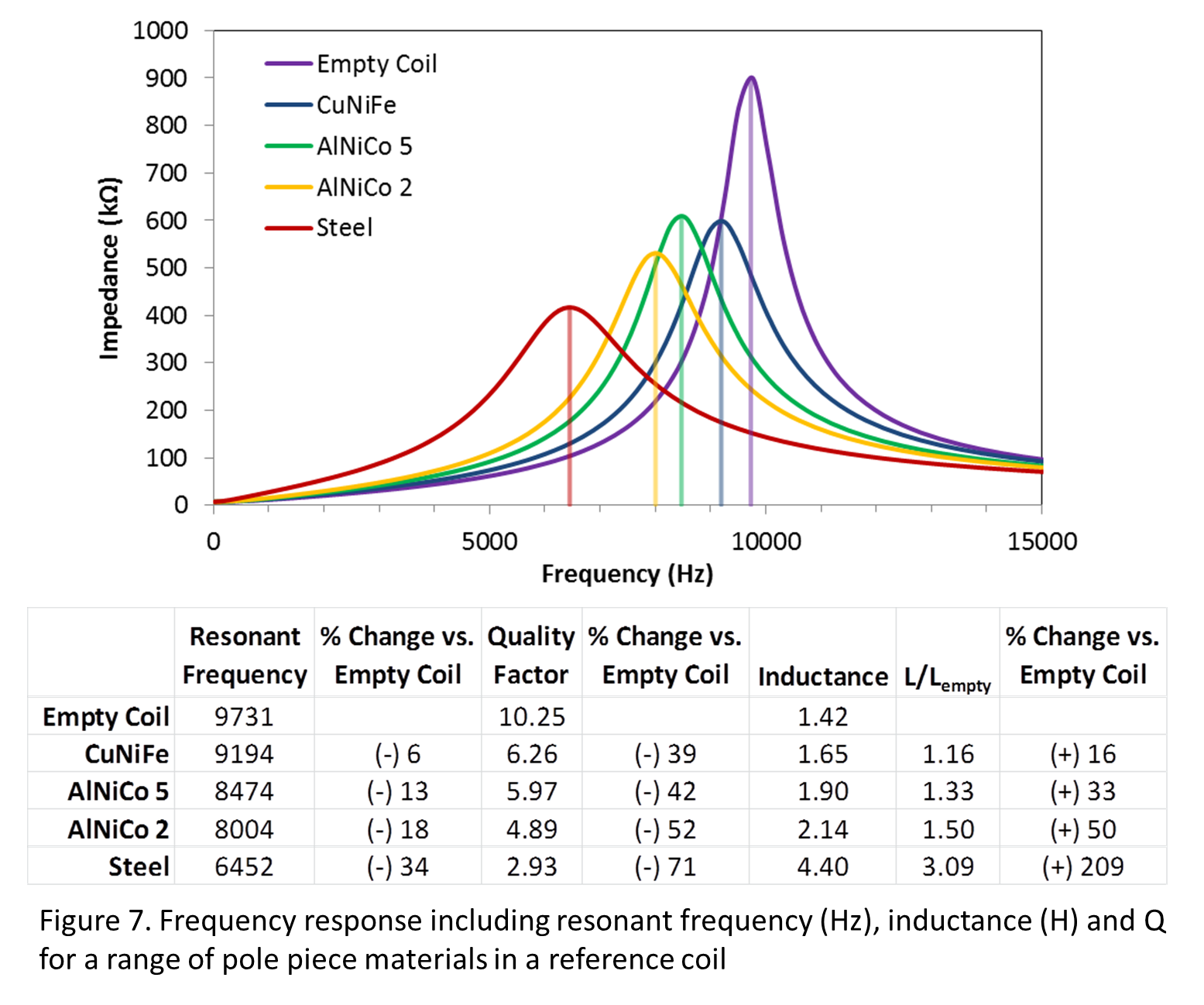In the course of developing the Zexcoil hum canceling format, I was faced with some insurmountable engineering problems with the materials that are conventionally used in Strat-style single coil pickups. As I have been explaining, the pole piece is primarily responsible for defining the timbre of a passive electric guitar pickup, and in the case of single coils it is the electromagnetic properties of AlNiCo alloys (and most specifically AlNiCo 5) that define the classic Strat tone. The problem was, AlNiCo alloys don’t work very well in the Zexcoil format because they can’t effectively close the magnetic dead spot between the D and G strings (where the magnetic polarity flips so we can get hum canceling). So I was forced to develop an understanding of what it was exactly that caused AlNiCo alloys to “sound” like they do and how I could get the same response from different materials, materials capable of closing the magnetic seam.
We think we were successful in solving the problem, but we’ll let you judge that by your impressions of our pickups. What we also got though, was a physical model for the electro-magnetic response of pole piece materials that basically allows us to create a map of tonal characteristics. We use this map in the design of all of our pickups. Since this is a basic model, the general responses are not limited to Zexcoil pickups, and pickup performance in general can be interpreted in the same context.
But we’ve struggled with how to make that information accessible to players to the extent that they can use it to guide their own pickup choices. We’re going to try some new things coupled with the roll out of our Z-Core™ and Z-Series™ models this summer. One of the things we’re going to do is provide a lot of the electrical specs for the various models.
In order for that information to be useful, it’s necessary to place the raw numbers in a tonal context. Resistance, Inductance, Resonant Frequency, Quality Factor, that’s all great: but what does it SOUND like? We’re going to attempt to answer that question, or at least provide some good guidance that might allow players to interpret the electrical specs more easily. We’ll start here by discussing the electrical parameters that we consider critical and describing what they are and what they mean in a terms of pickup performance.
First, the most ubiquitous electrical specification in use today, and by most accounts the most meaningless, Resistance. Electrical resistance is exactly what it sounds like; it’s the tendency of a material to resist electric current. Resistance is measured in Ohms, the symbol for which is “Ω”. Sometimes you’ll see a “k” in front of the“Ω”, and this means multiply by 1,000. So for example, 250 k Ω is the same as 250,000 Ω, it’s just shorthand. In almost all electric guitar pickups, resistance is a function of only two things; 1) the total length of wire that encompasses the pickup’s coils and 2) the gauge (or more accurately: thickness) of that wire. You can think of resistance like the width and length of a pipe that you are trying to pump water through. The narrower and longer the pipe, the harder it is to push to get the water through. So then, the thicker the wire (or the lower the gauge number), the lower the electrical resistance. The longer the wire, the higher the electrical resistance.
Most Strat style single coil pickups use an identical design and dimensions, the same 42 awg copper wire and similar AlNiCo 5 pole pieces. In this limiting case of “all other things being equal”, resistance actually is a pretty good descriptor of pickup performance. That’s one reason that it has become so widely used. But, change one thing and it starts to get a lot less meaningful. Change the wire gauge, and the resistance for the same length of wire changes. Change the pole piece and the output will change, even at the same resistance (we’ll talk about some of those effects in the next blog post on Inductance). Even change the material used for the wire, say from copper to silver as in the Seymour Duncan Zephyr pickup, and resistance will change at the same length of wire since resistivity (resistance per unit volume) is a property of the material and silver is a better conductor, in that it has inherently lower resistivity than copper.
So, resistance is not a great number as an absolute measure of pickup response. In the Zexcoil format, we pretty much use the fattest wire we can for any given winding level, and we may use 2 or 3 different wire gauges in a single pickup to get them tuned where they need to be given our unconventional magnetics. Resistance also represents a loss of efficiency, and in keeping with our over-arching philosophy of maximizing efficiency, we basically try to keep the resistance as low as possible for any given design.
Pickup Resistance and Pot Values
One place where resistance does become important is in how the pickup interacts with the controls. The simplest way to think about a potentiometer (“pot”) in a guitar is as a gate. A typical guitar control is just a variable resistor in a circular format. The knob turns a wiper that is contacting a semi-circular resistive strip, with one end of the strip connected to ground. When on “10”, the full resistance of the pot blocks the path to ground. When the pot is set to “0” that block is removed, and pretty much all of the signal goes to ground and we get no volume. When the pot is on “10”, most of the signal is retained, but some of the higher frequencies can manage to sneak through the pot and get lost to ground. The higher the value of the pot, relative to the pickup, the less high end is lost. Go back to the water analogy. Think about the volume pot/pickup system as a garden hose with a pin hole in it. The water coming out of the nozzle at the end of the hose is like the signal going out to the amp. With a small pin hole in the hose, almost all of the water in the hose still comes out the nozzle, but just a little bit of spray will escape through the pin hole. That spray is like the high end being lost through the volume pot. A 250 k pot versus a 500 k pot is like a bigger hole in the hose so more spray is lost. A volume pot on zero is like a hole in the hose big enough so that all of the water comes out the hole and none makes it to the nozzle. Strat style single coils, with resistances on the order of 5,000 Ohms or so, generally use 250 kΩ pots. Hum buckers, which typically have higher resistance than single coils – approaching 10,000 Ω, are usually better balanced with 500 kΩ pots. A good rule of thumb is that the pot value should be 25-50x the value of the pickup.
We refer to this scenario of attaching a resistance along with the pickup as “loading”. Tone pots (at “10” anyway, when you start dialing down the resistance of the tone pot, the tone capacitor comes in to play and things get a lot more complicated) represent a similar “load” on the pickup as a volume pot. In fact, when you have both a 250 kΩ volume and tone pot connected the effective resistance to ground is only 125 kΩ, so more signal (highs go first remember) can bleed over the lower barrier. A “No Load” tone pot is one in which there is a physical break in the resistive strip just below “10” on the dial. When the wiper is in the “10” position then, the pot is disconnected from ground and the load is removed. With a no load tone pot on “10” the only path to ground is through the volume pot. This has the audible effect of maintaining more of the high end “air”, and the tone will darken up noticeably when the tone pot is engaged just below “10”, especially through a clean amp. Go back again to the water analogy. A no load pot is like putting a bandage over the pin hole when the pot is on “10”, so the hole in the hose is plugged up and the spray is not allowed to escape. Just below “10”, as the resistive strip is engaged, it’s like the bandage has been removed and the spray through the pin hole is allowed out. We like to use no load pots on the neck and bridge positions, and we especially like the way they open up the “in between” positions. For most typical control layouts, the bridge pickup can benefit from tone pot loading, so we don’t use them much there. One exception would be the Convertible for Bridge where we like to use the no load tone as a “load toggle” between the two modes; unloaded for the higher resistance series mode to let all of the power come through and loaded down a bit more to attenuate the highs on the lower resistance parallel mode.








